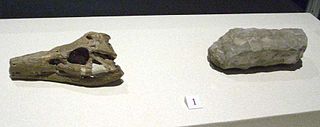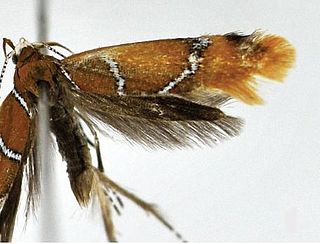Related Research Articles

The giant panda, also known as the panda bear or simply the panda, is a bear native to south central China. It is characterised by large, black patches around its eyes, over the ears, and across its round body. The name "giant panda" is sometimes used to distinguish it from the red panda, a neighboring musteloid. Though it belongs to the order Carnivora, the giant panda is a folivore, with bamboo shoots and leaves making up more than 99% of its diet. Giant pandas in the wild will occasionally eat other grasses, wild tubers, or even meat in the form of birds, rodents, or carrion. In captivity, they may receive honey, eggs, fish, yams, shrub leaves, oranges, or bananas along with specially prepared food.

Rosaceae, the rose family, is a medium-sized family of flowering plants, including 4,828 known species in 91 genera.

Gansus is a genus of aquatic birds that lived during the Aptian age of the Early Cretaceous (Aptian-Albian) period in what are now Gansu and Liaoning provinces, western China. The rock layers from which their fossils have been recovered are dated to 120 million years ago. It was first described in 1984 on the basis of an isolated left leg. It is the oldest-known member of the Ornithurae, the group which includes modern birds (Neornithes) and extinct related groups, such as Ichthyornis and Hesperornithes.

Sinopterus was a genus of tapejarid pterodactyloid pterosaur from the Aptian-age Lower Cretaceous Jiufotang Formation of Chaoyang, Liaoning, China. It was first described and named by Wang Xiaolin and Zhou Zhonghe. Three species have been classified in this genus, though only two are generally considered to be valid. Sinopterus is known for its proportionally large skull, which has a birdlike pointed beak, a long bony crest that starts with a tall premaxilla and goes back along the middle of the skull to form a point overhanging the rear of the skull, and its lack of teeth.

Huaxiapterus is a genus of tapejarid pterodactyloid pterosaur from the Aptian-age Lower Cretaceous Jiufotang Formation of Chaoyang, Liaoning, China. It is the second genus of tapejarid from this formation, after Sinopterus. Three species are known, though they may not actually form a natural group with each other. It was first named by Lü Junchang and Yuan Chongxi.
Sinocyclocheilus is a genus of freshwater fish in the family Cyprinidae endemic to China, where only found in Guangxi, Guizhou and Yunnan. Almost all of its species live in or around caves and most of these have adaptions typical of cavefish such as a lack of scales, lack of pigmentation and reduced eyes. Several species have an unusual hunchbacked appearance and some of the cave-dwellers have a "horn" on the back, the function of which is unclear. In contrast, the Sinocyclocheilus species that live aboveground, as well as a few found underground, show no clear cavefish adaptions. They are relatively small fish reaching up to 23 cm (9.1 in) in length. The individual species have small ranges and populations, leading to the status of most of the evaluated species as threatened. Many species populations in the genus have yet to be evaluated by the IUCN.
Anabarilius is a genus of ray-finned fish in the family Cyprinidae, most of them only occurring in China. Many of the species have very restricted geographic range and have been negatively impacted by introduced species, fishing, and habitat degradation; the IUCN Red List includes five Anabarilius species that are either endangered or critically endangered and one species that is considered extinct.

Triplophysa is a genus of fish in the family Nemacheilidae found mainly in and around the Qinghai-Tibet Plateau in China. Currently, the genus is a mixed assemblage of species. Some lineages have been identified and treated as subgenera, but as Wikipedia follows Fishbase for fish species these have been treated as subgenera in Wikipedia, although Kottelat and the Catalog of Fishes treat them as genera. FishBase, however, includes these in Triplophysa without specifying subgenera and treats the names given by Kottelat as synonyms.

Yunnanilus is a genus of small stone loaches that are endemic to southeastern China, especially Guangxi and Yunnan. They are found in rivers, streams and lakes; some species are restricted to caves.

The Jiufotang Formation is an Early Cretaceous geological formation in Chaoyang, Liaoning which has yielded fossils of feathered dinosaurs, primitive birds, pterosaurs, and other organisms. It is a member of the Jehol group. The exact age of the Jiufotang has been debated for years, with estimates ranging from the Late Jurassic to the Early Cretaceous. He et al. (2004) used argon - isotope radiometry to confirm biostratigraphic age estimates. They confirmed an Early Cretaceous, Aptian age for the Jiufotang Formation, 120.3 +/-0.7 million years ago. Fossils of Microraptor and Jeholornis are from the Jiufotang.

Hsisosuchus is an extinct genus of crocodyliform from China. Currently there are three species within this genus: H. dashanpuensis is from the Middle Jurassic, while H. chungkingensis and H. chowi are from the Late Jurassic. It is likely to have been a medium-sized predator.
Shenqiornis is a bird genus of the Enantiornithes. It was found in the Qiaotou Member of the Huajiying Formation of Hebei Province, China, and is therefore of uncertain age. The Qiaotou Member may correlate with the more well-known Early Cretaceous Yixian Formation, and so probably is dated to the Aptian, around 122 million years ago.

Tuber is a genus in the Tuberaceae family of fungi. It includes several species of truffles that are highly valued as delicacies.
Anabasis is a genus of snout moths. It was described by Carl Heinrich in 1956. The genus was long thought to contain only one species, the cassia webworm.
Anabasis medogia is a species of snout moth. It was described by Hou-Hun Li and Ying-Dang Ren in 2010. It is found in Tibet, China.

Promalactis is a genus of moths of the family Oecophoridae.

Orchideae is a tribe of orchids in the subfamily Orchidoideae. It has been divided into two subtribes, Orchidinae and Habenariinae. The subtribe Orchidinae alone contains about 1,800 species. However, although some phylogenetic studies have established the monophyly of the subtribes, the generic boundaries are unclear, with many genera as traditionally circumscribed being paraphyletic or even polyphyletic. Species of genera such as Habenaria and Platanthera have been placed into both subtribes. A 2017 molecular phylogenetic study found that both subtribes did form clades, but did not formally recognize Habenariinae, because of missing genera and uncertainty over generic boundaries. The Asian species of Orchideae, in particular, have been subject to repeated changes of generic placement from 2012 onwards.

Yongjinglong is an extinct genus of titanosaur sauropod dinosaur known from the Early Cretaceous of Lanzhou-Minhe Basin of Gansu Province, China. It contains a single species, Yongjinglong datangi.
Glycomyces anabasis is an endophytic bacterium from the genus of Glycomyces which has been isolated from the roots of the plant Anabasis aphylla from Xinjiang in China.
Sinankylosaurus is a genus of ankylosaurian dinosaur from the late Cretaceous Period of Shandong, China. The genus contains a single species, Sinankylosaurus zhuchengensis, known from a near-complete right illium. The describers explain that the discovery of Sinankylosaurus not only expands knowledge of Zhucheng dinosaur species, it also shows the similarity between dinosaurs of eastern Asia and North America.
References
- ↑ Li, L.-X. & H.H. Li, 2011: A new species of the genus Anabasis Heinrich from China (Lepidoptera: Pyralidae: Phycitinae). Acta Zootaxonomica Sinica36 (3): 792-794. Abstract and full article:
| | This Phycitinae-related article is a stub. You can help Wikipedia by expanding it. |